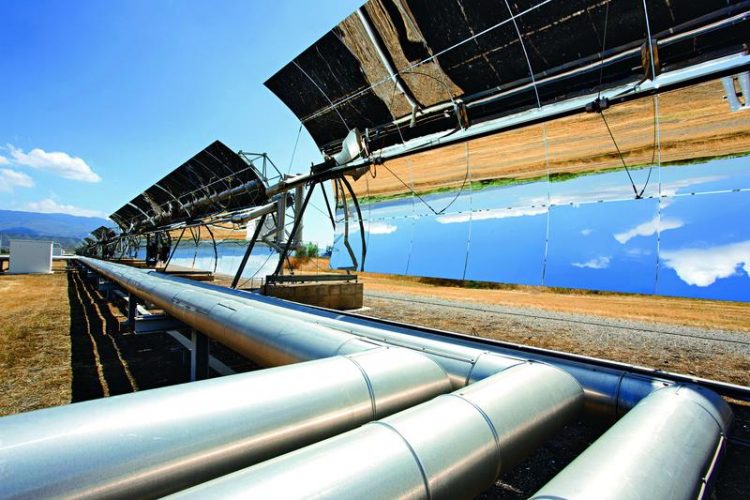Producing electricity with concentrated sunlight

Test facility on the Plataforma Solar in Almería in Spain where researchers are, among other things, testing and optimising parabolic mirrors. (© DLR - CC-BY 3.0)
The use of high-temperature solar heat for generating electricity has become an established technology. Scientists are now currently working on further optimising the components and concepts. The BINE-Themeninfo brochure “Solar thermal power plants” (II/2013) presents the main research areas. The authors describe the bases for solar thermal power plants, storage technologies and quality assurance processes.
More than 95% of the commercially operated solar thermal power plants are parabolic trough systems. In 2017, a further one is scheduled to enter operation in the southern Moroccan town of Ouarzazate on the edge of the Sahara Desert. The fully planned and funded power plant is designed to supply up to 500 MW of electricity.
To achieve this, large parabolic mirrors will concentrate sunlight onto absorber tubes. The thermal oil flowing through the tubes will be fed into a power plant block. Here the stored heat is transferred to a water circuit. This drives a steam turbine that is used to generate electricity.
A cheaper version of the parabolic trough technology is provided by Fresnel systems. Because the incident solar rays are less concentrated in this version, the collectors have greater optical losses. A challenge for the scientists is to control the high temperatures of about 500 °C on the receiver. Another research goal is to provide constant steam parameters.
To ensure that solar thermal power plants work efficiently, the quality of components and systems must be continually checked. Here, for example, the proportion of the reflected radiation and its direction play an important role. The latter is influenced by the mirror shape and slope. In order to assess this, the scientists are deploying optical measurement processes.
The authors of the BINE-Themeninfo brochure are Professor Robert Pitz-Paal and further employees from the Institute of Solar Research at the German Aerospace Centre (DLR).
The BINE-Themeinfobrochure, which can be obtained free of charge from the BINE Information Service at FIZ Karlsruhe, is available online at www.bine.info or by calling +49 (0)228 92379-0.
Press contact
Uwe Milles
presse(at)bine.info
About BINE Information Service
Energy research for practical applications
The BINE Information Service reports on energy research topics, such as new materials, systems and components, as well as innovative concepts and methods. The knowledge gained is incorporated into the implementation of new technologies in practice, because first-rate information provides a basis for pioneering decisions, whether in the planning of energy-optimised buildings, increasing the efficiency of industrial processes, or integrating renewable energy sources into existing systems.
About FIZ Karlsruhe
FIZ Karlsruhe – Leibniz Institute for Information Infrastructure is a not-for-profit organization with the public mission to make sci-tech information from all over the world publicly available and to provide related services in order to support the national and international transfer of knowledge and the promotion of innovation.
Our business areas:
• STN International – the world’s leading online service for research and patent information in science and technology
• KnowEsis – innovative eScience solutions to support the process of research in all its stages, and throughout all scientific disciplines
• Databases and Information Services – Databases and science portals in mathematics, computer science, crystallography, chemistry, and energy technology
FIZ Karlsruhe is a member of the Leibniz Association (WGL) which consists of 87 German research and infrastructure institutions.
http://www.bine.info/en/press/press-releases/press/pressemitteilung/mit-konzentr… – Download cover, press release and info-pdf
http://www.bine.info/en – BINE Informationsdienst english
Media Contact
All latest news from the category: Architecture and Construction
Newest articles

Breaking boundaries: Researchers isolate quantum coherence in classical light systems
LSU quantum researchers uncover hidden quantum behaviors within classical light, which could make quantum technologies robust. Understanding the boundary between classical and quantum physics has long been a central question…

MRI-first strategy for prostate cancer detection proves to be safe
Active monitoring is a sufficiently safe option when prostate MRI findings are negative. There are several strategies for the early detection of prostate cancer. The first step is often a…

Microelectronics Science Research Centers to lead charge on next-generation designs and prototypes
Pacific Northwest National Laboratory to contribute leadership to national effort in microelectronics design and development. Microelectronics run the modern world. Staying ahead of the development curve requires an investment that…



